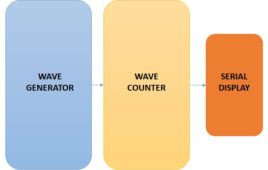The need for this project aroused when once I was trying to interface uart and multiplexed ssds together. The problem was that I had to do 2 process simultaneously that is receive characters from uart send them back to uart, print them at the same time update all ssds. Now ssds use persistent of vision that is a particular ssd is turned on digit is displayed on it then after few microseconds other ssd is turned on and corresponding digit is displayed and this goes on for other ssds also. So as a solition to this, a mechanism had to be developed that after few us turns on a ssd displays digit, then after few us turns other ssd on displays corresponding digit and at the same time receive digits from uart put them back and displays on term. And apart from displaying on term also update digits to be displayed on ssds.
How to Interface 7 Segment Display with ARM7 based LPC2138 Microcontroller
Seven segment displays are very commonly used in meter displays, etc. In this tutorial we’ll interface seven segment display(s) to our ARM7 based microcontroller LPC2138. For those who are new to ARM refer to previous tutorial (LED Interfacing). The task is to display all Numbers (0-9) and Alphabets on SSD. LPC2138 is a 32-bit microcontroller, so while coding we’ll be dealing with IO Registers that are 32-bit wide. For Interfacing a 7-segment we choose P0 (P0.0 to P0.7; 8 Pins out of 32 IO Pins on Port-0).Let’s use a common anode type display, a simple push-button switch, Resistors, etc. a,b,c,d,e,f terminals of display are connected to P0.0 to P0.6 respectively. Common terminal is supplied with +Vcc through a current limiting resistor R. Keep on reading to find out how whole system is assembled and what coding is applied to make it work.
Introduction to ARM Microcontroller – LED Interfacing with LPC2138 (ARM7)
With the exponentially increasing modernization in Electronics Field, particularly in Embedded systems, it’s now a necessary step for Engineers, students and hobbyists to move along with Industry. There’s a need to grasp skills on recent industrial tools and systems. ARM Processors are one of such advancements in Embedded stream which serve as major platform for many of the modern systems. ARM stands for 32 bit Advanced RISC (Reduced Instruction Set Computer) Machines designed and licensed by British company ARM Holdings. As an IP core business, ARM Holdings itself does not manufacture its own electronic chips, but licenses its designs to other semiconductor manufacturers. ARM-based processors and systems on a chip include the Qualcomm Snapdragon, TI, etc. Using a RISC based approach to computer design, ARM processors require significantly fewer transistors than processors that would typically be found in a traditional computer.
Wave Counter using ARM7 Microcontroller
In this input wave is given through I/O pin and then counting begins. Here also time scheduling is used. Timer 0 is set as fast interrupt request and after every 2 us ISR is executed. And a static variable count is incremented and if count==1 the status at I/O pin is stored in pre variable. Then again after 2 us ISR is executed and count is again incremented if count==2 status at input I/O pin is stored in nex variable and count=0. So after this we have previous state in pre and next state in nex. Then pre is compared with 0 and nex with 1 now if pre == 0 and nex == 1 means a positive edge has occurred so another variable num is incremented num++. Find out project circuit diagram, understand its code and put it to work.



